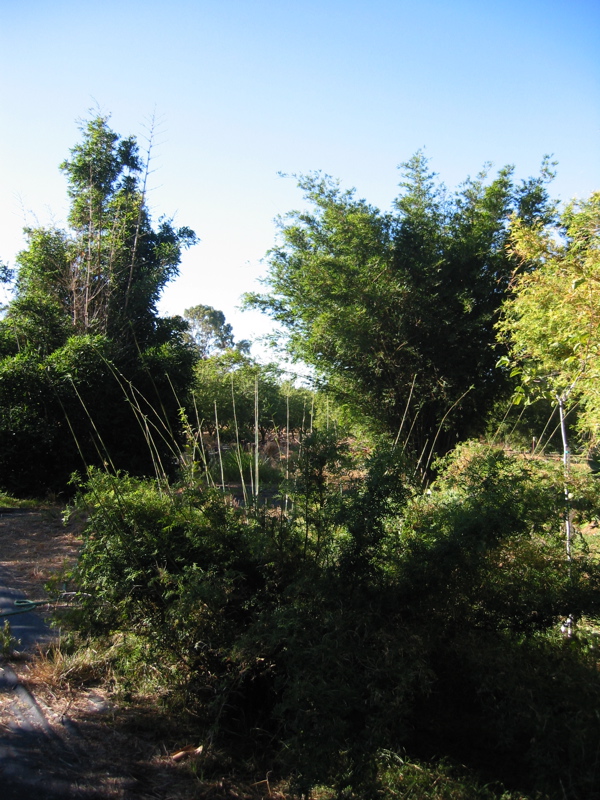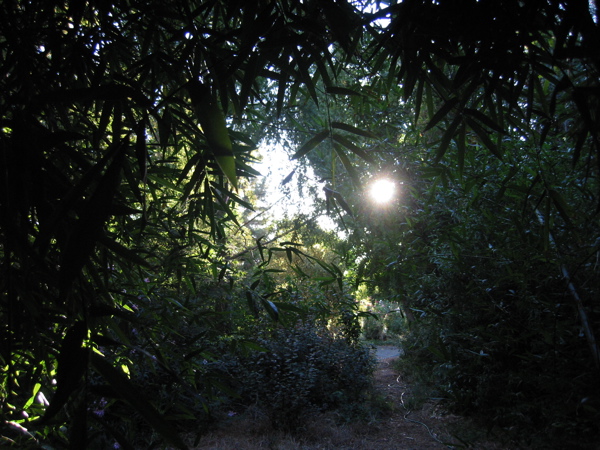Bamboo My Father Planted
From the Davis Enterprise, August 28 2008
About the same time I went into the retail nursery business (1981), I gave my mother a book about succulents which sparked a renewed interest in collecting and propagating them (see July's column). It doesn't take long before you have a surplus of succulents, given how easy they are to propagate, so she began providing them to me to sell. Then my father started loading them into their Jeep Wagoneer, and trundling them off to nearby nurseries in Southern California to sell to local retailers there.
"As long as you're visiting all these nurseries, Dad," I said innocently one day, "keep an eye out for interesting clump-forming bamboos. All I can find up here are the runners."
A brief explanation.
There are types of bamboo that spread vigorously, which most people are familiar with by reputation. Phyllostachys aurea (Golden bamboo), Phyllostachys nigra (Black bamboo), and others have horizontal-growing surface stems called rhizomes that can spread several feet in a season. Bamboo lovers call these "runners." But many of our most attractive and useful bamboos spread very slowly, forming tight clumps. They are not invasive at all, and take up about as much room in the garden as a large shrub. Members of the genus Bambusa are all "clumpers," and these were what I was seeking. A lot of wholesalers had Phyllostachys, but in the mid-1980's availability of clumping bamboo was very limited here.
 A survivor! 'Tiny Fern' bamboo planted in the late 1980's struggled and nearly died. Rediscovered� a few years late and pampered a bit, it has regrown to be a central specimen in our bamboo area. To the rear are (left to right) Giant timber bamboo, Punting pole bamboo, and Alphonse Karr hedge bamboo.
A survivor! 'Tiny Fern' bamboo planted in the late 1980's struggled and nearly died. Rediscovered� a few years late and pampered a bit, it has regrown to be a central specimen in our bamboo area. To the rear are (left to right) Giant timber bamboo, Punting pole bamboo, and Alphonse Karr hedge bamboo.
So a couple of years later he was president of the American Bamboo Society. There had been a mild previous interest in bamboo: when they built their San Diego home in the 1950's they had planted a Giant timber bamboo (Bambusa oldhami) in a corner of the patio, at what happened to be the highest point in the neighborhood, flanked by a couple of Washingtonia palms. They grew fast to make a dramatic, lush skyline silhouette. Bamboo gives fast results, and except for watering it is pretty carefree. So he already had a respect for the plant, and as he visited nurseries he began to realize what a diverse family it was.
Three gardens.
That was about the time we purchased a rural property, so we designated about half an acre for various of the clumpers he found for us. And for himself: there are now large specimens of different species lining the private road on their suburban Southern California lot. Others went into containers: dozens of pots, planters, and raised beds filled with clumpers and runners. It's a good thing La Jolla is a pretty benign climate. My mother hand-waters several dozen containers of bamboo, succulents, and other specimens every few days! The last time I was down there I counted 79 plants in pots, not even counting the greenhouse.
About the same time, the local chapter of the bamboo society got involved with Quail Botanical Gardens, a delightful small botanical garden in Encinitas (a coastal community north of San Diego). The bamboo society needed an import site, and Quail could use a good collection of bamboo. Now, with over 100 types, "Quail Botanical Gardens has the largest collection of Bamboo in the Northern Hemisphere." [press release, 2006]. Dad didn't plant them all, but he was instigator, propagator, and organizer of many of the planting and maintenance projects. In that nearly frost-free climate they can grow some of the giant tropical species. Quail Gardens is well worth a visit if you are in Southern California.
Back to the Dixon farm. I had only one rule: no runners (this makes me a wimp to true bambuseros). The first were offshoots of that original B. oldhami, which we integrated into the nascent landscape to provide texture and contrast among other trees and shrubs. To our surprise, they provided habitat for songbirds and nesting sites for hummingbirds which like the dense foliage cover. Twenty years later I still have hummingbirds nesting in the timber bamboo every summer.
 The common name of Bambusa ventricosa is Buddha's Belly bamboo, referring to the interesting swollen nodes it develops when stressed. Well watered it is a vigorous clump-forming bamboo to 20' tall. Our two plants are close enough that their shoots arch together, creating a dark bamboo nook.
The common name of Bambusa ventricosa is Buddha's Belly bamboo, referring to the interesting swollen nodes it develops when stressed. Well watered it is a vigorous clump-forming bamboo to 20' tall. Our two plants are close enough that their shoots arch together, creating a dark bamboo nook.
Every visit brought new clumpers. An overgrown clump of 'Alphonse Karr' (a variety of B. multiplex) was divided into many pieces and planted on 3' centers, creating a hedge 30' long and about 15' tall. With its gold-striped shoots, dense foliage, and upright habit, 'Alphonse Karr' is one of the best bamboos for Sacramento Valley gardens. Another large piece of B. oldhami was chopped up and planted to form a row of giants over 30' tall. By the way, chopping through clumping bamboo roots is pretty arduous. My dad highly recommends a Sawzall reciprocating saw, and be sure to keep roots and leaves wet through the whole process.
Two plants of Buddha's belly (B. ventricosa) were sited a little too close together, a serendipitous mistake which created a small space where you can be nearly surrounded in a thicket. Two plants of Punting-pole bamboo (B. tuldoides) were purchased at auction, and fortunately I gave each enough room to show off the graceful form.
A little plant of 'Tiny Fern' (a dwarf variant of B. multiplex) got lost in the weeds, mowed repeatedly and given up for dead. A few years ago - over ten years later! -- I notice it sprouting a couple of forlorn shoots. Never give up on bamboo! I pulled the weeds and began watering and fertilizing it. Today this little resurrected plant is in the center of our bamboo collection. 'Fernleaf' and 'Tiny Fern' are two of the best for small yards and are excellent for containers.
Some were experiments. An in-law provided a castoff of Beechey's bamboo (B. beecheyana), a giant species which is reputed to be too tender to grow here. It grew, it froze, it grew again and froze again. It was kind of like having a gigantic 30' tall perennial that died to the ground each winter, which makes this species hard to recommend here. Common bamboo (B. vulgaris), also considered tender here, froze four winters in a row.
 Large clumps of bamboo can help frame a landscape area. Bold-leaved tropical plants can provide a nice contrast to the busier-looking leafy bamboo. Here a path winds by Punting pole bamboo (Bambusa tuldoides), with a hardy Chinese Yellow banana (Musella lasiocarpa) nearby.
Large clumps of bamboo can help frame a landscape area. Bold-leaved tropical plants can provide a nice contrast to the busier-looking leafy bamboo. Here a path winds by Punting pole bamboo (Bambusa tuldoides), with a hardy Chinese Yellow banana (Musella lasiocarpa) nearby.
But bamboo can create its own ecosystem: the buildup of old leaves and culm sheaths (the papery structure that surrounds the shoot and is shed as it expands) provides an effective mulch, preventing the roots from freezing and desiccating in the winter. So as years went by, each of these "too-tender" species survived, then thrived. Beechey's has 4" diameter shoots which spread outward. The shoots emerge in September and reach their 30' height by the end of October; you do the math!
Using bamboo in the landscape.
All you have to do is plant bamboo, water, and wait. Pretty soon you have big, bold dramatic landscape plants. So while we blended the first bamboo into our landscape, we've adapted the landscape design to the later plantings. Not much grows under a clump bamboo because of the dense roots, and not much is necessary: the shoots and leaves provide all-season beauty, and there are seasonal transitions as the new shoots form, the sheaths peel away, and the shoots change color. But lots of plants can complement bamboo. Tropical-leaved plants such as bananas and cannas provide contrast in summer; nearby flowering trees such as almonds, plums, crabapples, and magnolias mark the spring. Paths can curve around them and beckon to hidden nooks.
Bamboo creates its own atmosphere as it rustles in the slightest breeze, moves in the wind, and reaches to the sky. There is no quieter place in the garden than in the midst of bamboo: you hear just the sounds of the bamboo itself. It's easy to see why it is so venerated.
My father is bedridden now, but he has left a legacy in three gardens. I would never have a half-acre of bamboo if it weren't for him, and he would never have done it if it weren't for my innocent comment over 25 years ago!
For more information about bamboo for the Sacramento Valley: http://redwoodbarn.com/DE_bamboo.html
For more bamboo resources: http://bamboo.org/
© 2008 Don Shor, Redwood Barn Nursery, Inc., 1607 Fifth Street, Davis, Ca 95616
www.redwoodbarn.com
Feel free to copy and distribute this article with attribution to this author.
Click here for Don's other Davis Enterprise articles
